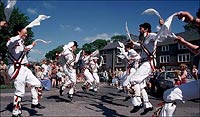 |
News | Irina Kozyreva | The studio | Festivals | Performances | Photo | Contacts |
 |
News | Irina Kozyreva | The studio | Festivals | Performances | Photo | Contacts |
What is choreography? Many people think that choreography is a dance or a ballet. The notion of choreography is much wider. It includes not only national and everyday dances and classical ballet. This word is of Greek origin and literally means “to write a dance”. But later everything that has relation to the art of dancing obtained the notion of choreography.
A dance is an art, and every art must reflect life in vivid artistic form. The specific feature of choreography is that thoughts, feelings and sufferings are conveyed not through speech but by means of movement and mimicry.

Choreography was born at the outset of the humanity. Even in the pristine society there existed dances reflecting labour activities, animal movements, magical and martial dances. Thus a person appealed to the powers of nature. All of this, however, can be seen nowadays in the African peoples’ art.

Life conditions changed and so did the character and subject-matter of the art, including the national choreography.
Even Gogol in his “Petersburg notes of 1836” wrote: “Look, folk dances are in every part of the world. Spanish dances not like Swiss and Scottish, Russian not like French and Asian. Even in different part of one state dances differ. Where does such diversity of dances come from? It is from the people’s character, its life and way of occupation…”

The folk dance is one of the most spread and the oldest kinds of folk arts. During the long history of its development the folk dance has always been connected with way of life and customs of a person (birth, wedding…)
Folk dance is inseparable from song. It has influenced the character and the style of the dance.

Plehanov wrote: “The art begins when a person again and again evokes feelings and thoughts in himself which he experiences under the influence of the surrounding reality and gives them a vivid graphical expression.”
Every new epoch, new political, economic and religious conditions were reflected in forms of the public consciousness including folk arts. It was the evolution of dance forms. The old ones died out, the new ones were born, enriching and altering their lexis. 
On the basis of the above said we can make a conclusion that folklore is the basics of the professional art. The meaning of studying folklore is enormous; the riches of the folk wisdom and beauty lay in folklore.